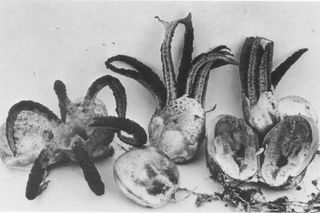People Are Freaking Out Over This Monster Fungus That Smells Like Rotting Crab
Meeeeuurghhhkkkkk!
That's not the sound the Clathrus archeri fungus makes when it erupts from its egg-sack. But it sure seems like it should be.
When the squid-like stinkhorn fungus raises its gloopy, toothed arms to the heavens, it might look like it's enacting some salutation to an alien sun. But its purpose is in fact much more earthly: to attract swarms of hungry flies that will spread spores embedded in the fungus' sticky arm-gloop across the surrounding countryside. (You know, normal horrifying fungus stuff.)
C. archeri isn't new, but many people are just now discovering its purplish, diabolic majesty through a viral post on Reddit.
Twitter embed:
"What continent is that from so I make sure never to go there?" the top commenter asked.
The fungus is native to New Zealand and Australia, but it spread through Asia and Europe in 1914 — apparently stowed away among military supplies during the First World War, according to the Royal Botanical Gardens' site, Kew.org. And in 1982, the mycologists David Arora and William R. Burk announced that C. archeri had spread to North America. The specimens they found in California likely descended from spores carried over on exotic plants, the researchers said. Those specimens are part of a small collection of the freakish fruiters that remains active on this side of the Pacific. [Microscopic Worlds Gallery: Fascinating Fungi]
Sign up for the Live Science daily newsletter now
Get the world’s most fascinating discoveries delivered straight to your inbox.
Termed "devil's fingers" outside scientific circles, C. archeri typically turns up in clusters in the soil around decaying wood chips and old stumps, or in leaf litter, according to Kew.

Arora and Burk wrote in their 1982 paper in the journal Mycologia that C. archeri first appears as an innocent-looking white or beige ball. This object is not hard, but rather covered in a smooth or scaly membrane that deforms under the finger of anyone brave enough to touch it.
That ball swells and grows turgid before a lattice of up to 12 tapering white arms burst out, their inward-facing sides smeared with a stinking purple tissue seeded with spores. The egg-like ball remains at the base of the fungus as the arms reach upward from the opening to a height of 1.5 to 3 inches (4 to 8 centimeters). After the interlinked, spongy-textured arms strain as high as they can skyward, they split and unfold earthward "like the petals of a flower" Arora and Burk wrote in their paper — but, you know, slimier.
Eventually, the spread arms dry out into brittle, blackish husks.
Kew states that the fungus, which is related to stinkhorn species that turn up on dinner plates in some countries, is neither toxic nor dangerous. Still, you might want to avoid biting into one. Arora and Burk broke from the generally strict scientific tone of their '82 paper to note that the things smell "like rotting crab."
Yum.
Originally published on Live Science.

